
Kampen municipality / Gemeente Kampen (Ov)
The name Kampen is first mentioned in 1277, although a settlement must have existed on its location since ca. 1150. In the middle Ages Kampen became an important member of the Hanseatic League. Its position as the major trading city of The Netherlands was lost after ca. 1430. Due to its bad economic situation, Kampen has not developed a lot since the 18th century, resulting in one of the best preserved old towns of The Netherlands. The city is mostly protestant and has two protestant theologic universities. Part of the municipality of Kampen are several villages, like Ijsselmuiden (which is directly on the other side of the river Ijssel) and Zalk.
De naam Kampen wordt het eerst genoemd in 1277, hoewel er al sinds ca. 1150 op deze locatie een nederzetting moet hebben bestaan. In de Middeleeuwen werd Kampen een belangrijk lid van de Hanze. De stad verloor haar positie als de belangrijkste handelsstad van Nederland na ca. 1430. Als gevolg van de slechte economische situatie stagneerde de ontwikkeling van de stad vanaf de 18e eeuw, wat heeft geresulteerd in een van de best bewaarde oude steden van Nederland. De bevolking is voornamelijk protestant en de stad heeft twee protestantse theologische universiteiten. Onderdeel van de gemeente Kampen zijn diverse dorpen, zoals Ijsselmuiden (dat aan de overkant van de IJssel ligt) en Zalk.

The Bovenkerk or St. Nicolaas as its former catholic name is, is a big Gothic church that since 1580 has been Kampen's major protestant church. During several restorations most of the church's outside skin has been replaced, resulting in a rather new look. The tower has been spared from this fate.
Location: Koornmarkt 28
De Bovenkerk, of St. Nicolaas zoals de oorspronkelijke katholieke naam luidt, is een grote gotische kerk die sinds 1580 de belangrijkste protestantse van Kampen is. Tijdens een aantal restauraties is het grootste deel van de buitenste laag stenen vervangen, waardoor de kerk hier en daar vrij nieuw oogt. De toren is dit lot gespaard gebleven.
Locatie:
Koornmarkt 28
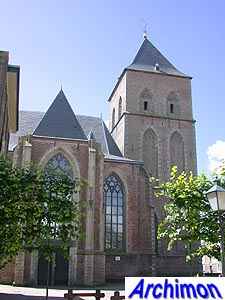
The Onze Lieve Vrouwe Kerk ('Church of Our Lady'), also known as Buitenkerk, is a Gothic church dating from the 14th century. It replaced a chapel which at that time still stood outside the walls of the town. After having been protestant property for more than two centuries this church was returned to the catholics in 1809.
Location: Kerkstraat 1
De Onze Lieve Vrouwe Kerk ('Kerk van Onze Lieve Vrouw'), ook wel bekend als Buitenkerk, is een gotische kerk uit de 14e eeuw. De kerk verving een kapel die op dat moment buiten de muren van de stad stond. Na meer dan twee eeuwen in protestantse handen te zijn geweest werd de kerk in 1809 teruggegeven aan de katholieken.
Locatie: Kerkstraat 1
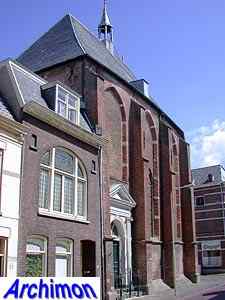
The Mennonite church is the former chapel of the St. Anna convent which was founded in the 1470's. In 1596, when the convent had been closed, the chapel became a Walloon church until 1808, and in 1823 was handed to the Mennonites. The entrance dates from a rebuilt in 1846-1847 by town architect Nicolaas Plomp, who removed the vaults and changed the windows as well.
Location: Broederweg 10
De
Doopsgezinde kerk
is de voormalige kapel van het St. Annaklooster
dat werd gesticht in de jaren 1470. In 1596, toen het klooster werd
gesloten, diende de kapel tot 1808 als Waalse kerk. In in 1823 werd
de kapel aan de Mennonieten gegeven. De entree dateert van een
verbouwing in
1846-1847 door stadsarchitect Nicolaas Plomp, die tevens de
gewelven verwijderde en de vensters wijzigde.
Locatie: Broederweg 10
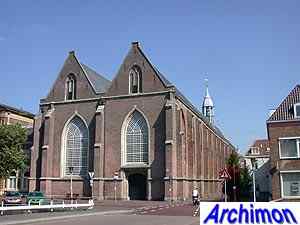 The Broederkerk
was the
church of the Franciscan monastery and dates from the first half of the
14th century. In 1578 the new protestant rulers forced the monks to
leave Kampen, after which the church was adapted for protestant use.
The church consists of two aisles of equal height and width and is
extremely long.
The Broederkerk
was the
church of the Franciscan monastery and dates from the first half of the
14th century. In 1578 the new protestant rulers forced the monks to
leave Kampen, after which the church was adapted for protestant use.
The church consists of two aisles of equal height and width and is
extremely long. Location: Broederstraat 16
De Broederkerk was de kerk van het Franciscanenklooster en dateert uit de eerste helft van de 14e eeuw. In 1578 dwongen de nieuwe protestantse machthebbers de monniken om Kampen te verlaten, waarna de kerk werd aangepast voor protestants gebruik. De kerk bestaat uit twee zijbeuken van gelijke hoogte en breedte en is extreem lang.
Locatie: Broederstraat 16
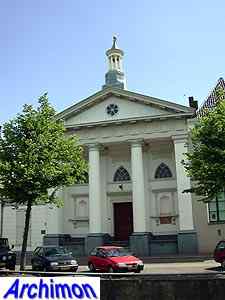
The Lutheran church is a building in neo-classical style, more precisely the neo-Grec variant, designed by the aforementioned Nicolaas Plomp and built in 1843.
Location: Burgwal 85
De Lutherse kerk is een gebouw in neoclassicistische stijl, meer bepaald de neo-Grec variant, en werd ontworpen door de eerder genoemde Nicolaas Plomp en gebouwd in 1843.
Locatie: Burgwal 85
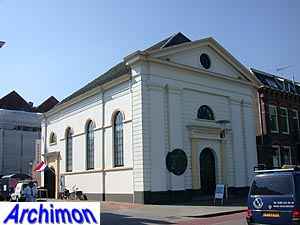
The
former synagogue is another
neo-Classical design, again by N. Plomp. In 1943 it was closed. Since
1984,
after a restoration, it has been used for exhibitions.
Location: Ijsselkade 33
De
voormalige synagoge
is een neoclassicistische ontwerp van wederom N. Plomp. In
1943 werd zij gesloten. Sinds 1984, na een restauratie, wordt het
gebouw gebruikt voor
tentoonstellingen.
Locatie: IJsselkade 33
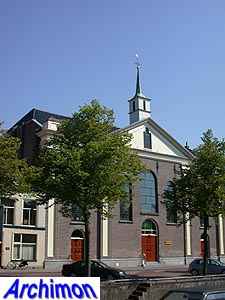
The
Gereformeerde Burgwalkerk is
a building in neo-Classical style, built in 1874-1875. It was designed
by the otherwise unknown architect Krijgsman.
Location: Burgwal 60
De
Gereformeerde Burgwalkerk
is een gebouw in neoclassicistische stijl,
gebouwd in 1874-1875. De kerk werd ontworpen door de verder
onbekende architect Krijgsman.
Locatie: Burgwal 60
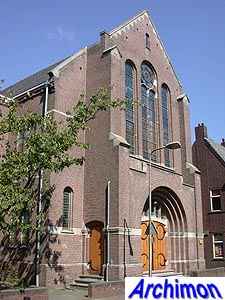
The Gereformeerde
Nieuwe Kerk dates
from 1911-1912 and was designed by architect Tj.
Kuipers, who combined his usual Rationalist
style with neo-Romanesque elements.
Location: Broederweg 34
De
Gereformeerde Nieuwe Kerk
dateert uit 1911-1912 en is ontworpen door
architect Tj. Kuipers , die zijn
gebruikelijke rationalistische stijl combineerde met
neoromaanse elementen.
Locatie: Broederweg 34
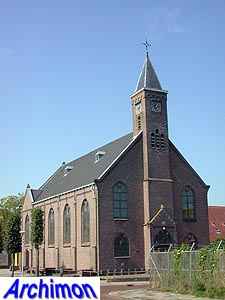
The
reformed Noorderkerk dates
from 1916. It's a one-aisled building with a small
tower and
windows and details in simple neo-Gothic shapes. It was designed by H.
Westerhof. In 2016 it closed and it now contains a physiotherapy practice.
Location: Noordweg 53
De hervormde Noorderkerk dateert uit 1916. Het is een eenbeukig gebouw met een kleine toren en ramen en details in eenvoudige neogotische vormen en werd ontworpen door H. Westerhof. De kerk werd in 2016 gesloten en huisvest nu een fysiotherapiepraktijk.
Locatie: Noordweg 53
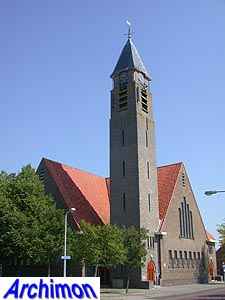
The Geref.
Westerkerk is a
cruciform building in moderate
Expressionist style, designed by B.W. Plooij. It
was built in
1929-1930.
Location: Wilhelminalaan 97
Het
Geref. Westerkerk
is een kruisvormig gebouw in zakelijk-expressionistische stijl,
ontworpen door B.W. Plooij . De kerk werd gebouwd
in 1929-1930.
Locatie: Wilhelminalaan 97
Ijsselmuiden

The reformed church is an old but drastically altered building with a Romanesque tower, a Gothic choir and a big neo-Gothic main space, added in .
Location: Dorpsweg 53
De hervormde kerk is een oud, maar drastisch veranderd gebouw met een romaanse toren, een gotisch koor en een grote neogotische hoofdruimte.
Locatie: Dorpsweg 53

Located
in Ijsselmuiden are the
cemeteries of Kampen, including a Roman Catholic one, standing on which
is this cemetery chapel in a more or less
neo-Gothic style.
It was built in 1889
and was designed by architect A.C. Boerma.
Location: Rondeweg
In
IJsselmuiden zijn de begraafplaatsen van Kampen gelegen, waaronder de
rooms-katholieke waar deze begraafplaatskapel
in min of meer neogotische stijl staat. De kapel werd gebouwd in 1889
en
werd
ontworpen door architect A.C. Boerma.
Locatie: Rondeweg

The Roman Catholic church O.L. Vrouwe Onbevlekt Ontvangen dates from 1919 and was designed by J. Stuyt, who designed several similar village-churches in neo-Romanesque style.
Location: Burg. van Engelenweg 137
De rooms-katholieke kerk O.L. Vrouwe Onbevlekt Ontvangen dateert uit 1919 en werd ontworpen door J. Stuyt, die diverse soortgelijke dorpskerken ontwierp in neoromaanse stijl.
Locatie: Burg. van Engelenweg 137
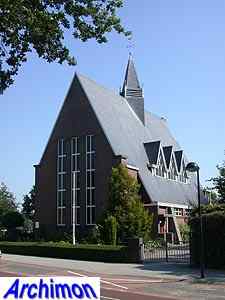
The Gereformeerde
kerk dates
from 1933 and was designed in a moderate Expressionist style by B.T.
Boeyinga.
Location: Burg. van Engelenweg 177
De Ned. Gereformeerde
kerk dateert uit 1933 en werd ontworpen in een
gematigd expressionistische stijl van B.T. Boeyinga.
Locatie: Burg. van Engelenweg 177
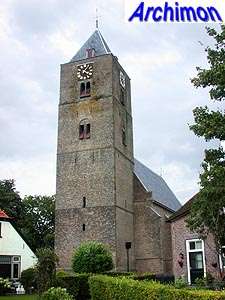
While the reformed church dates from ca. 1400 and is in Gothic style, the tower is Romanesque and part from the 12th, part from the 13th century.
Location: Kerkplein 22
Terwijl de hervormde kerk zelf dateert uit ca. 1400 en in gotische stijl is, is de toren romaans en deels gebouwd in de 12e en deels in de 13e eeuw.
Locatie: Kerkplein 22